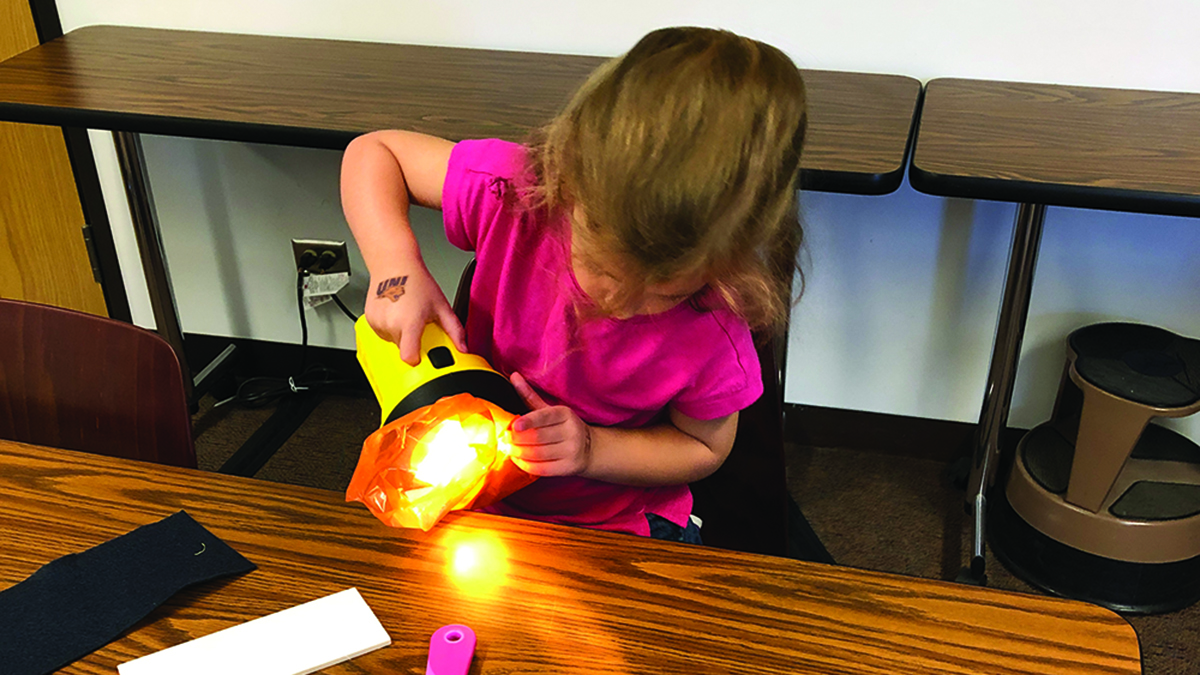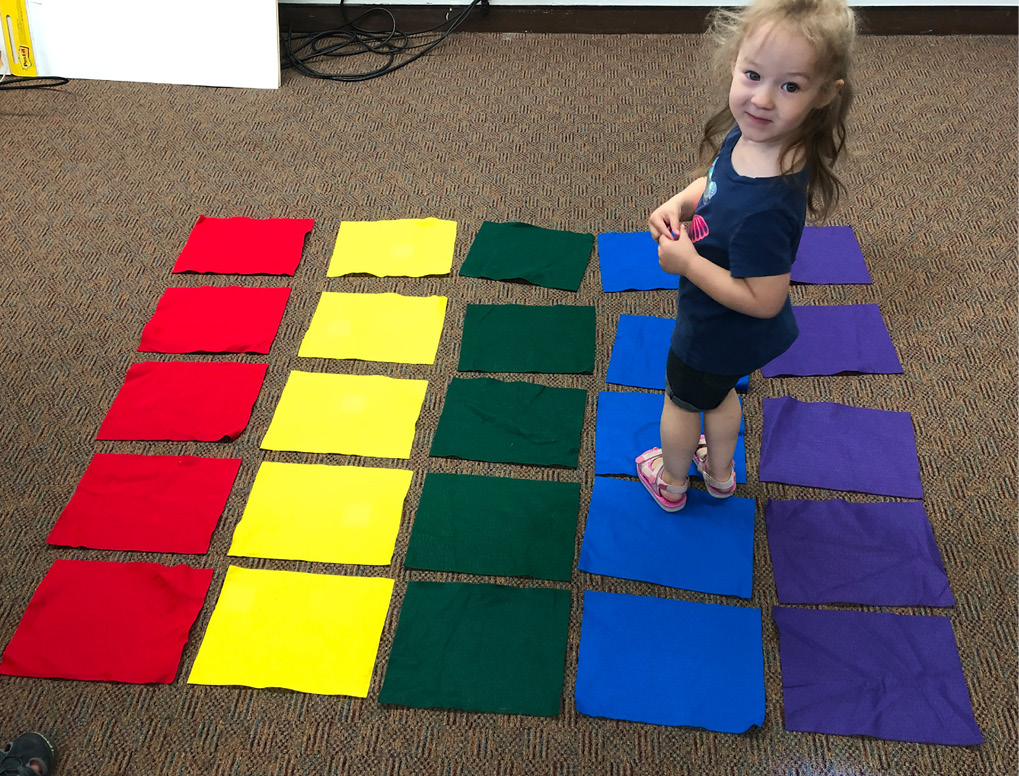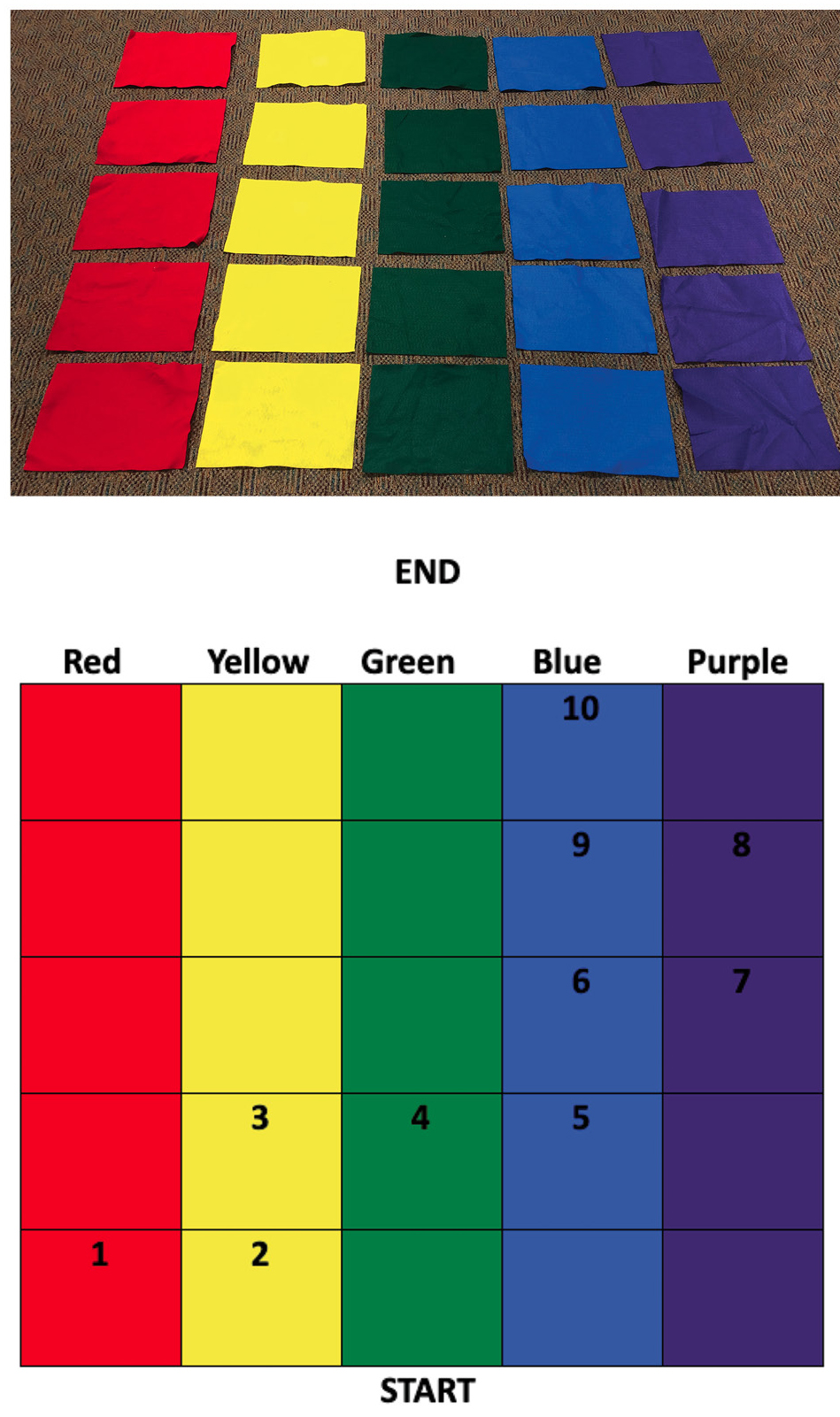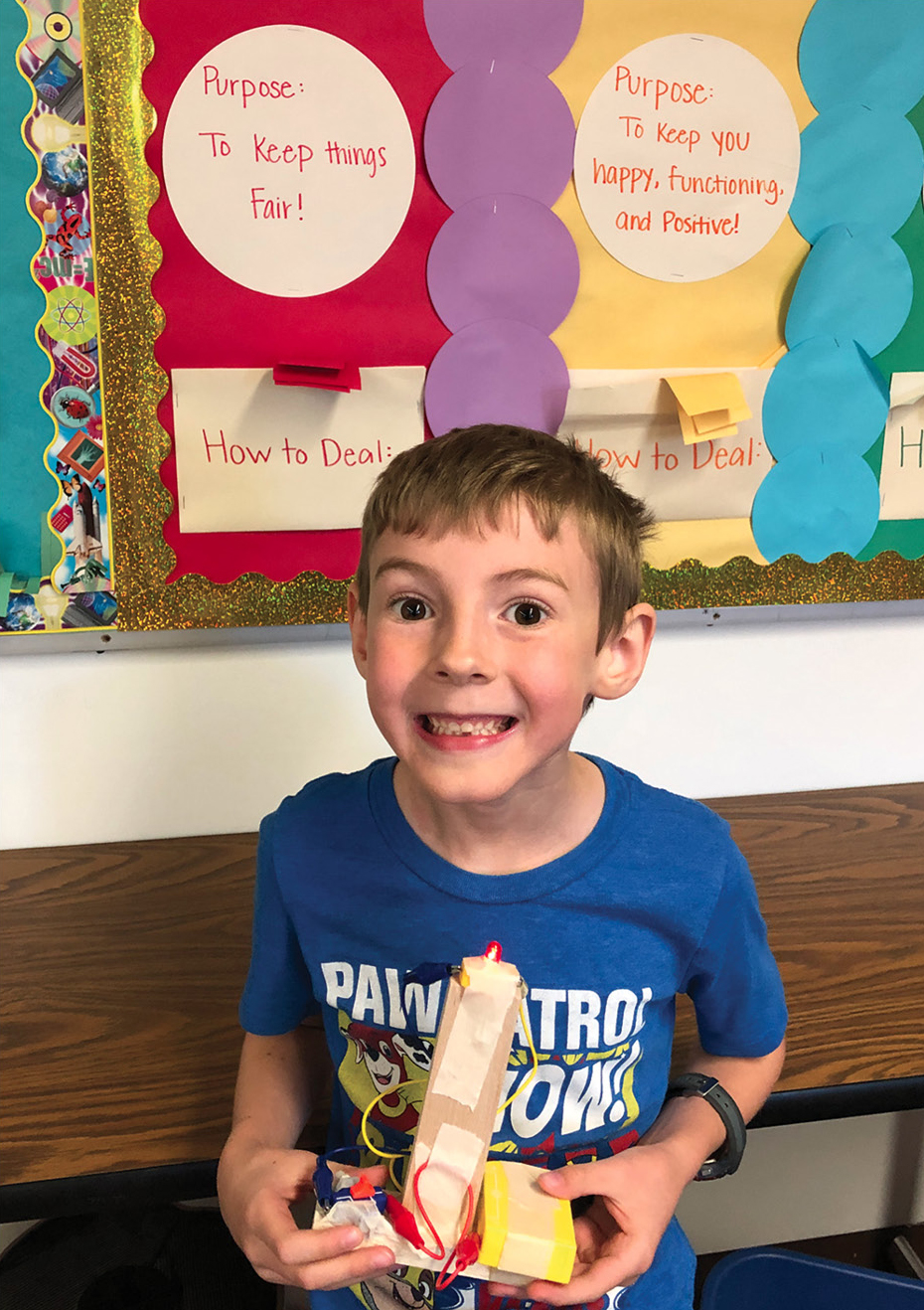feature
Shining a Light on the 'T' in STEM
thinking using activities about light
Science and Children—May/June 2021 (Volume 58, Issue 5)
By Sarah Nolting, Jesse Wilcox, Naryah Moore-Dilworth, and Mackenzie Grenko

Even though children interact with the natural and designed worlds daily, they don’t often think and act like scientists and engineers. The Next Generation Science Standards call for engaging students in practices that scientists and engineers use (NGSS Lead States 2013), but it’s also important to explicitly teach thinking approaches that scientists and engineers use. One way to help children think and act like scientists and engineers is to engage them with computational thinking. Computational thinking (CT) is “a problem-solving methodology that can be automated and transferred and applied across subjects” (Barr and Stephenson 2011). This can involve breaking problems into smaller pieces, recognizing patterns, and making basic algorithms to solve problems (see Table 1 for CT ideas for elementary). When students are taught how to engage with computational thinking, their capacity to abstract, represent information differently, and problem-solve often improves (Yadav et al. 2014). We use a 5E model to begin to teach students about light (partially addressing 1-PS4-3) and then scaffold students to solve problems by communicating with light using CT (1-PS4-4).
Materials list
The materials you use don’t really matter as long as you have at least two different materials for each effect of light.
Reflective Materials
- Mirror
- Reflective duct tape (or other reflective material besides a mirror)
Opaque Materials
- Cardboard
- Rock
- Wood
Transparent
- Plastic bottle
- Clear rock glass
Translucent
- Plastic cup with color
- Plastic bag with color
- Thin fabric with color
Engage: Placing Objects in the Path of a Beam of Light (30 minutes)
We begin the lesson by holding up different objects (e.g., a large rock, red plastic sealable bag) and telling students we would like them to investigate what happens when they put the objects in the path of a beam of light from a flashlight. To ensure students get materials in a safe and orderly way, we have one student from each group come and pick up a plastic shoebox of materials for their group of three or four students. After discussing safety considerations, such as properly handling the materials and ensuring the materials are in the middle of the table, we give students about five minutes to explore. We walk around, listen to the groups’ conversations, and differentiate with questions when necessary. We ask what students were noticing and they say things like, “We shined the light through the blue cup and now the light is blue!” or “The mirror and the tape both reflect light.” We want students to group the objects, so we ask each group “How could you group the objects based on how they act with the light?” To differentiate, we sometimes ask more guiding questions to groups such as, “How is the light different with a mirror compared to paper?” Students often respond, “The light reflects off the mirror, but it doesn’t shine through the paper.” With our questioning and support, students realize they can organize the objects based on how much light shined through the objects.
Most of the groups of students decide to organize the objects into three groups: “see-through,” “not see-through,” and “light reflects.” We help refine students’ thinking by holding up two pieces of glass; one green, one clear. We ask, “While the light goes through each of these, why might you put these in two different groups?” Students note the light changes color when it goes through green glass and doesn’t change color for the clear glass. Once the students put the materials into groups, we have the class join us at the front of the room. We write down their descriptions and write the scientific terms next to them as follows: very see-through (transparent), kind of see-through (translucent), not see-through (opaque), and reflective.
To help students see the relationships between the categories and to use the scientific language, we draw a continuum on the board. We write opaque on one side of the continuum. We then ask, “How would we place the other categories you came up with on this line?” With some discussion and teacher guidance, students often decide that translucent would be somewhere in the middle and transparent would be toward the opposite side of opaque. We then discuss the group of reflective materials. We discussed how these items were not transparent because no light passed through, but they weren’t opaque because a lot of light shined back. We then ask, “What should we do with reflective if it doesn’t seem to fit anywhere?” Students were then able to determine that reflective should stay as its own group and not go on the continuum.
| Table 1. Computational thinking ideas for elementary children. | ||||||||||
|---|---|---|---|---|---|---|---|---|---|---|
|

A child navigates the rainbow maze.
Explore: Rainbow Maze (30 minutes)
After we feel students have a good understanding of how light can pass through objects, we engage students in an activity we call the “rainbow maze” to see if students can use what they have learned to communicate with light (1-PS4-4). We place sets of six felt fabric sheets with the colors of the rainbow on the floor in different parts of the room (Figure 2a) and have students go to the felt sheets in groups of two. The goal of the maze is to get a student to step on the correct felt fabric sheets in a certain order to get from one side of the maze to the other. We tell students that one student will get the map (Figure 2b), and the other will be the one traveling through the maze. We then present the problem: The student who has the map can’t talk to the student moving through the maze. We then asked the students, “How could you guide a partner through the maze using only light?” A lot of students reference items from the first activity such as colored plastic and flashlights that they could use to communicate. Sometimes students turn the flashlight on and off or shine it through a specific colored object as one of their codes for which direction to move. Most often, students simply hold up different colored objects as a code. If students are color blind, we have found placing the names of the colors above the felt fabrics and the map helps those students succeed.

Rainbow maze (top) and map example (bottom).
If students need help, we differentiate by modeling their task on a set of felt fabric. We stand on the red felt sheet and ask, “If you want your partner to go to the right from here, what could you do?” Students note they could hold up a yellow plastic sheet, which would tell their partner to move right. We tell students that they each will have a chance to use the map and go through the maze, ask what questions students have about the activity, and then break them up into groups of two around the room. The students definitely enjoyed the activity, and they wanted to go through the maze multiple times.
Once we see that each student has had the chance to both go through and direct someone through the maze (10–15 minutes), we gather students back together on the carpet. We ask students, “What did you try that helped you communicate with your partner?” Students often say a number of different things, but we focus on the comments related to computational thinking. For example, one of our students said, “We gave one direction at a time,” which relates to the CT idea of problem decomposition (see Table 1). We ask, “Why do you think giving one direction at a time helps so much?” A student said, “It’s easier to follow without getting confused.” We then explicitly asked, “Why do you think scientists and engineers do better when they break problems down into small pieces?” Students said, “It helps them not get stuck.” We then tell students we will try a new activity to see if they can break the problem down.
Explain: LightBot Jr. and Computational Thinking (45 minutes)
We use an app called LightBot Jr. to help students further develop CT skills. LightBot Jr. is a programming puzzle game where students program in directions (e.g., forward arrow, turning arrow, lightbulb) to try to get the bot to move to certain squares and light them up. We often show students the app on the screen and ask them how we could move the bot. We connect to the CT idea of algorithms (Table 1) by asking, “What steps should we take to get the Lightbot to light up?” and “Why does planning our steps help us solve problems?” We then give students a tablet and let them try it on their own while we walk around and help them.
After students have had some time to try out different levels on the app, we again gather them back on the carpet to explicitly draw their attention to CT. For example, we connect to abstraction/transfer (Table 1) by asking, “How was Lightbot like the Rainbow Maze?” Students often say, “You have to give directions without talking.” We then ask, “Why might it have been easier to do the Lightbot since we already did the Rainbow Maze?” Students respond, “We moved on the squares just like in the LightBot.” To connect to the CT idea of automation (Table 1), we ask, “Why might it be easier to program all of the moves into the LightBot rather than doing one at a time like we did with the Rainbow Maze?” Students often say, “It’s easy to see if we made a mistake.” We follow up with, “What could we do with the Rainbow Maze to make it faster?” Students note we could draw a picture with all of the steps on it. We have noticed these explicit conversations about how students have solved problems often help them start to internalize many of the CT skills.
Elaborate: Communicating With Light in the Real World (15 minutes)
To help students elaborate on what they have learned and connect it to the real world, we have students engage students in a think-pair-share and ask, “We have communicated using the Lightbot and the Rainbow maze in class. In what ways do we communicate using light in the real world?” If we need to guide students, we often ask more direct but still open-ended questions such as, “When a family member is driving, what are some things we see on the road that use light to communicate?” When we get to the whole-group share, students often say things such as, “Traffic lights!” and “Sometimes lights flash.” We ask students to explain how those lights communicate and students agree that green means go, yellow means slow down, and red means stop. They often mention that sometimes the lights flash yellow or red, which tells us what to do. We then ask, “How do other people know if they are going to stop or change directions?” Students quickly note that cars have brake lights to tell us they are stopping and turning signals to tell which way a car is turning.
To elaborate, we ask “What about in an emergency, how do we communicate with light in emergencies?” Students typically respond with, “Police cars, ambulances, fire trucks,” We then ask, “When you see lights from a police car, fire truck, or ambulance, what does it communicate to the driver?” Our students say, “When we see the lights behind us or if we hear the sirens, we know to slow down or pull over.” We then wanted the students to understand that we communicate with lights every day in different environments.
We then ask the students if they could think of any other times where they see lights that communicate something. We often hear things such as movie theaters with lights along the walkway, business signs, lights outside their house to let people know they are home, and lights on the stove to let them know it’s hot. We wrap up the discussion by asking, “Why do you think it is important for people to communicate with light?” The students gave answers about knowing what to do, keeping them safe, and helping them know how to act. A student aptly summarized, “Light helps us do things that we do every day.”
Evaluate: Designing a Way to Communicate Over a Distance (60 minutes)
As an assessment, we have students design a way to communicate to ships in the ocean in the dark. We start the task by showing students a picture of the ocean during the day and a picture of the ocean at night. We ask students, “When do you think it would be more dangerous for a ship to sail?” Students quickly agreed it would be at night. We then posed the challenge that students had to design a way to communicate with the ship to help it avoid hitting the shore. Students worked in groups of two to brainstorm ideas and construct their structures. Before students begin to build, we remind them of safety considerations such as properly carrying and using materials (scissors), wearing safety glasses and asking for help. Not surprisingly, many students designed structures that resembled lighthouses (Figure 3). We then asked students to evaluate which designs work best by asking questions such as: “How can we make sure boats can see the light from far away? and How do we warn all ships when they sometimes come from different directions?"

A student displays his lighthouse structure.
Through these guiding questions, students decided that taller buildings and brighter lights that move or can be seen from multiple directions should be used. To connect to the first activity of shining light through objects, we ask: “If we want to protect the light from wind or other weather conditions, what material could we put over the light?” Students sometimes struggle with this, so we bring back the box from the first activity and ask them which material (we hold up one transparent, one translucent, and one opaque) would work best. The students quickly decide that a transparent cover would work best to protect the light, but keep it so the ships can see the light well. We then have students redesign their structures to best warn the ships.
Conclusion
While computational thinking can be a useful tool to help students think more like scientists and engineers, we don’t want computational tasks to supersede science instruction. Rather than trying to find computational thinking tasks, we have found more success in using computational thinking strategies alongside our instruction to help students break down tasks into more manageable pieces and think about problems more systematically.
Sarah Nolting is an undergraduate student studying elementary education. Jesse Wilcox (jesse.wilcox@simpson.edu) is an assistant professor of STEM education. Naryah Moore-Dilworth is an undergraduate student studying elementary education, and Mackenzie Grenko is an undergraduate student studying psychology. All authors are at Simpson College in Indianola, Iowa.
Earth & Space Science Physics STEM Technology Elementary


